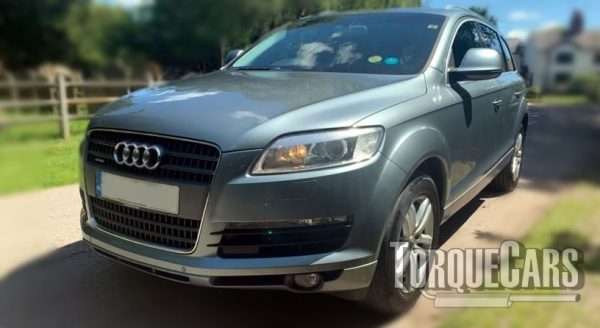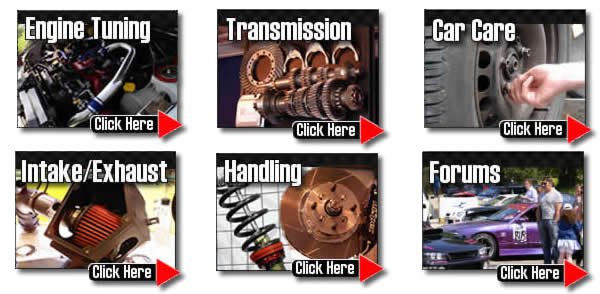Audi Q7 Tuning
"Thanks for reading my Q7 tuning guide."
The Q7 is the large SUV from Audi, that still manages to tick the fun to drive box, retaining it's practicality.
When you have a big heavy car that you want to move quickly your only option is to fit a large powerful engine, and that is exactly what Audi have done.
The choices on offer when the Q7 first launched were
- 3.6 FSI 2008–2009 3,597 cc VR6 FSI 280 PS (276 hp) at 6,200, 36.7 kg⋅m (360 N⋅m; 265 lb⋅ft) at 2,500–5,000
- 4.2 FSI 2008–2009 4,163 cc V8 FSI 350 PS (345 hp) at 6,800, 440 N⋅m (325 lb⋅ft) at 3,500
- 3.0 TDI 2005–2007 2,967 cc V6 turbo 233 PS (230 hp) at 4,000, 500 N⋅m (369 lb⋅ft) at 1,750–2,750
- 3.0 TDI 2007–2009 2,967 cc V6 turbo 240 PS (237 hp) at 4,000–4,400, 550 N⋅m (406 lb⋅ft) at 2,000–2,250
- 3.0 TDI clean diesel 2009– 2,967 cc V6 turbo 240 PS (237 hp) at 4,000–4,400, 550 N⋅m (406 lb⋅ft) at 2,000–2,250
- 4.2 TDI 2007–2009 4,134 cc V8 turbo 326 PS (322 hp) at 3,750, 760 N⋅m (561 lb⋅ft) at 1,800–2,500
- 6.0 TDI 2008– 5,934 cc V12 twin turbo 500 PS (493 hp) at 3,750, 1,000 N⋅m (738 lb⋅ft) at 1,750–3,250
All engines respond well to mapping and performance upgrades. We wouldn't want to spoil the Q7 with the wrong mods so lets take a look at the best mods for the Q7.

The only thing holding you back in your Q7 project is time, money and your imagination Plan ahead and research Q7 tuning to spare yourself making the usual costly mistakes we hear people complain about.

Improving the handling for DIY mechanics first priority in your Q7 tuning project. We suggest that you fit performance suspension and lower the car by 45mm (unless it's on Sline suspension already). Larger drops require arch work and really mess up the geometry.
The suspension that Audi use is actually very good although some don't like the firmness. There are some aftermarket kits around that retain the handling but soften the ride.
Turning our attention to the Q7's engine we need to get a bit more power out of the top end.
The best power gains come from larger engine sizes. The more you start with the bigger the return on investment so engine swaps are good value mods for small engined cars.
Engine tuning mods.
These are the tuning modifications are usually fitted by our members, decide how far you wish to go in your tuning project before you get going.
Engines offered for the Facelift in 2010
Petrol engines
- 3.0L V6 T FSI 272 PS (200 kW; 268 hp) at 4,750–6,500, 400 N⋅m (295 lb⋅ft) at 2,150–4,780
- 3.0L V6 T FSI (S-Line version) 333 PS (245 kW; 328 hp) at 5,500–6,500, 440 N⋅m (325 lb⋅ft) at 2,900–5,300
- 3.6L VR6 FSI 280 PS (206 kW; 276 hp) at 6,200, 360 N⋅m (266 lb⋅ft) at 2,500–5,000
- 4.2L V8 FSI 350 PS (257 kW; 345 hp) at 6,800, 440 N⋅m (325 lb⋅ft) at 3,500
Diesel Engines
- 3.0L V6 TDI 2,967 cc 240 PS (177 kW; 237 hp) at 4,000–4,400, 550 N⋅m (406 lb⋅ft) at 2,000–2,250
- 4.2L V8 TDI 340 PS (250 kW; 335 hp) at 4,000, 760 N⋅m (561 lb⋅ft) at 1,750–3,000
- 6.0L V12 TDI 500 PS (368 kW; 493 hp) at 3,750, 1,000 N⋅m (738 lb⋅ft) at 1,750–3,250
Then in 2015 the engine options were updated to meet new emissions regulations and standards.
- 2.0 TFSI -2016 1984 252 PS (249 hp; 185 kW) 370 N⋅m (273 lbf⋅ft)
- 3.0 TFSI -2015 2995 333 PS (328 hp; 245 kW) 440 N⋅m (325 lbf⋅ft)
Diesel engines - 3.0 TDI ultra 2015-2018 2967 218 PS (215 hp; 160 kW) 500 N⋅m (369 lbf⋅ft)
- 45 TDI -2019 2967 231 PS (228 hp; 170 kW) 500 N⋅m (369 lbf⋅ft)
- 3.0 TDI 2015-2018 2967 272 PS (268 hp; 200 kW) 600 N⋅m (443 lbf⋅ft)
- 50 TDI -2019 2967 286 PS (282 hp; 210 kW) 600 N⋅m (443 lbf⋅ft)
- e-tron 2016-2018 2967 387 PS (382 hp; 285 kW) 700 N⋅m (516 lbf⋅ft)
- SQ7 TDI -2016 3956 435 PS (429 hp; 320 kW) 900 N⋅m (664 lbf⋅ft)
Getting the best motorsport parts for your planned usage of the car is vital. Stage 3 (competition) mods just won't work well on the road making the car difficult to drive.
Modifying to STAGE 1:
Panel air filter, Sports exhaust, Remap, Suspension upgrade (drop 30-40mm), Alloy wheels, Lighter flywheel (DMF not single mass).
Modifying to Stage 2:
fuel pump upgrades, high flow fuel injector, Power/Sport clutch, Ported and polished head, Fast road cam, larger turbo/supercharger or hybrid unit.
Modifying to Stage 3:
Competition cam, Internal engine upgrades (pistons/head/valves), Adding or upgrading forced induction (turbo/supercharger), Engine balancing, Sports gearbox.
Peak power is all well and good but for a drivable and fun car you need a long torque band and perhaps extending the rev range.
In this article we shall give an overview and introduction to the best upgrades for your car, but we'd encourage you to spend some time on the site looking into the details of each type of performance part. Fast road cams offer one of the biggest performance gains for your money as far as a bolt on tuning parts goes on a NASP engine.
The intake and exhaust flow play a large part in your cars power band, but be careful here, getting this wrong can upset the idle and make the car impossible to drive in traffic. You'd need to follow a cam upgrade with other mods and finish with a reflashed ECU to fully realise your gains. Don't forget to pay attention to the fuelling when you are increasing the power - it makes the car more thirsty.
Most power losses, flat spots and erratic idling after uprated modifications are done can usually be traced to fuelling or timing issues.Uprating the injectors is another beneficial modification and will deliver sufficient fuel. Uprate the fuel pump to cope with the extra fuel requirements of your tuned Q7s uprated injectors.
Intake and Exhaust Tuning.
Now we move on to the intake and exhaust and ensure proper flow through the engine. Induction kits only help to boost power if your air intake is restricted!
The standard airboxes on Audi flow really well and are not a restriction, so adding an induction kit to most standard engines will see very little power gain and can cause flatspots as the engine runs lean. But if you have heavily modified your engine and it's need for air INCREASES DRAMATICALLY then an induction kit is the answer and will help remove this restriction.
Derestricting the air feed into the engine is a primary goal of car tuners so get a freer flowing air filter if you find that the car is running lean only if you find the car is running lean. Induction kits can sound great but due to the warm air in the engine bay they will not do much to increase power and actually rob you of power on most cars.
Sports exhausts balance the flow of gases through the engine. But if your exhaust pipe is too big, ie: over 3 inches bore, you will lose a great deal of the flow rate and end up losing power and torque.
*(NB: Diesel exhausts from Audi flow really well and very little gain is to be had by replacing it with a full performance equivalent, although the headers and filter can be improved.)
Airflow through the head can be dramatically increased with some professional polishing and ported. These should match and be setup to take into account any other engine mods.
Your clutch can seriously let you down if it starts to break and the standard clutches are only ever good for power gains of up to 46%. Fit an upgraded clutch to avoid power loss through the transmission. Turbo engines are just asking to be Reprogrammed.
You will see phenomenal power gains on most modern turbocharged cars including diesels making a remap one of the most cost effective and phenomenal modifications for your money.
Adding forced induction or twincharging the current setup, will see large power gains but this is usually too expensive to be cost effective. Superchargers are generally easier to add than turbos. With a turbo the boost curve is related exponentially to the engine speed making it difficult to map fuelling with.
Superchargers will give a boost which is proportional to engine speed so is easier to map. To cope with forced induction you will usually need to decrease the engines compression ratio .
Alloy wheel upgrades.
The benefits of alloy wheels include lowering your unsprung weight and more efficient brake cooling via the extra air flow they allow. The drawback to large rims on your Q7 is that you're changing your final drive ratio so this will have a detrimental effect on acceleration and performance.
Because of this aim to keep the overall rolling diameter of the wheel your OEM settings. In all cases without going bigger than 19 inches - yes we know the lads like running on 21's but it really wrecks the ride and handling in our opinion.
For more information on Tuning your car please join us in our friendly
forum where you can discuss Q7 options in more detail with our Q7 owners. It would also be worth reading our unbiased Audi tuning
articles to get a full grasp of the benefits and drawbacks of each modification.
Please help us improve these tips by sending us your feedback in the comments box below. We love to hear what our visitors have got up to and which mods work best for them on each model of car. Comments are used to improve the accuracy of these articles which are continually updated.
If you liked this page please share it with your friends, drop a link to it in your favourite forum or use the bookmarking options to save it to your social media profile.
Check out TorqueCars new YouTube channel, and see their awesome new content...
Feedback
Please use our forums if you wish to ask a tuning question, and please note we do not sell parts or services, we are just an online magazine.
Help us improve, leave a suggestion or tip
